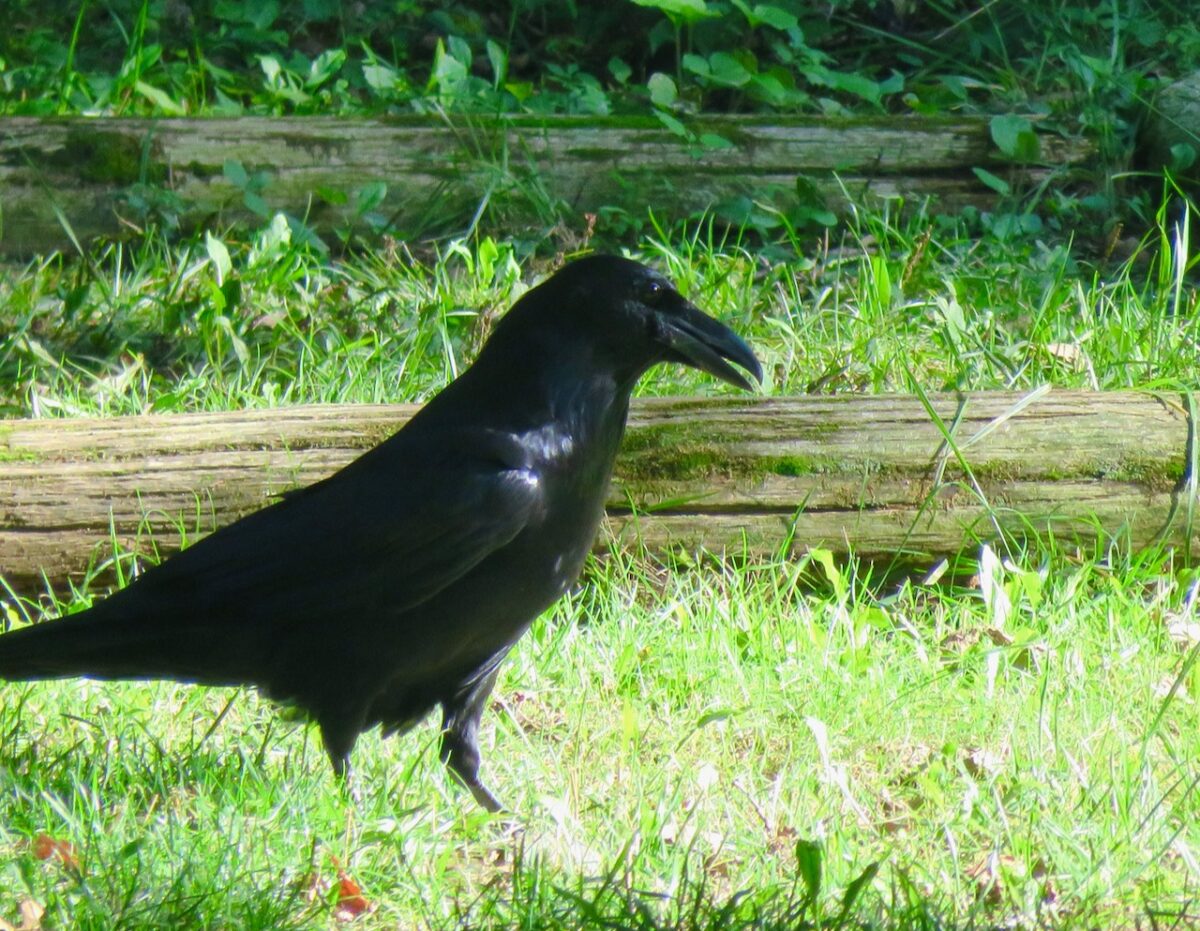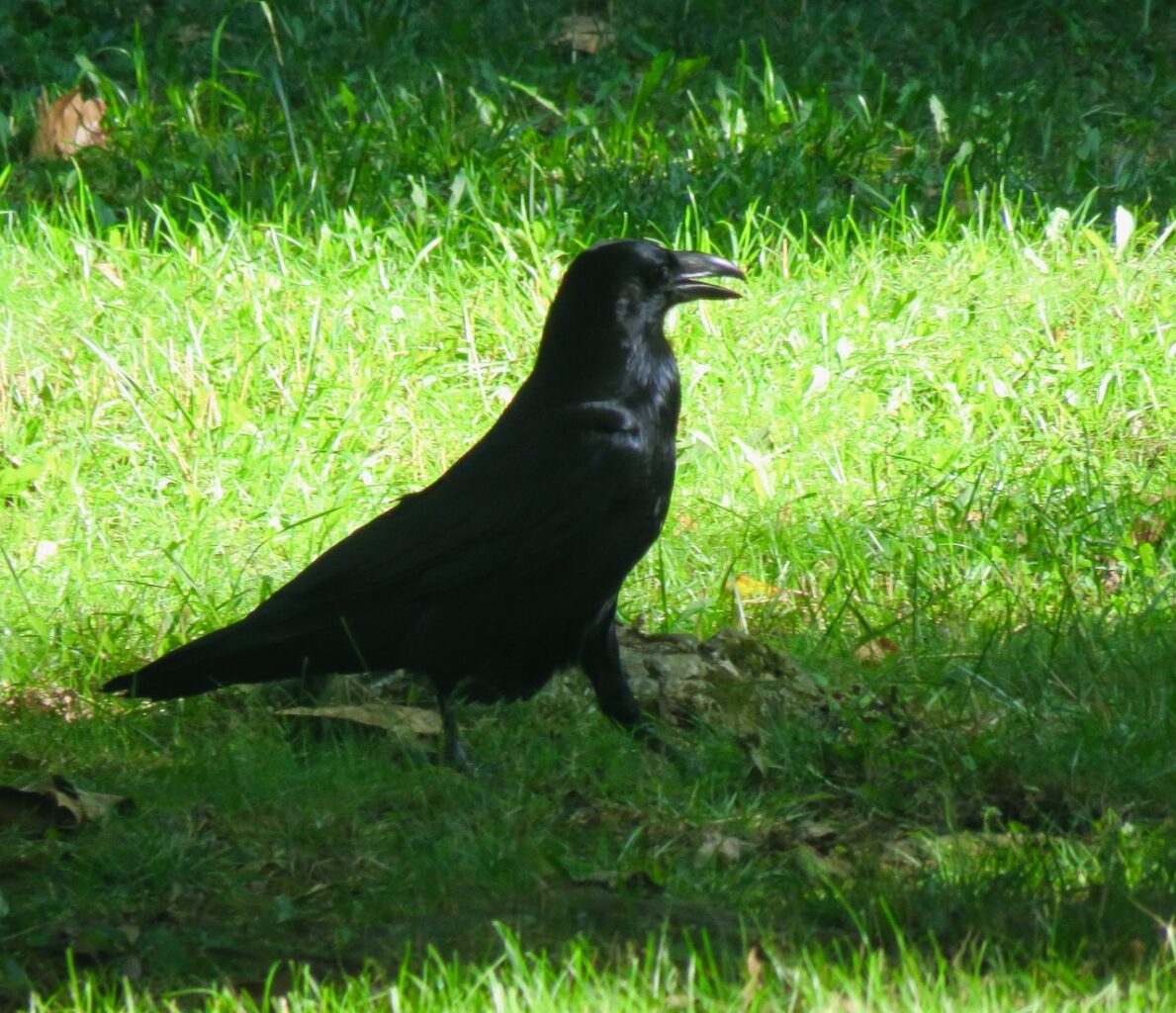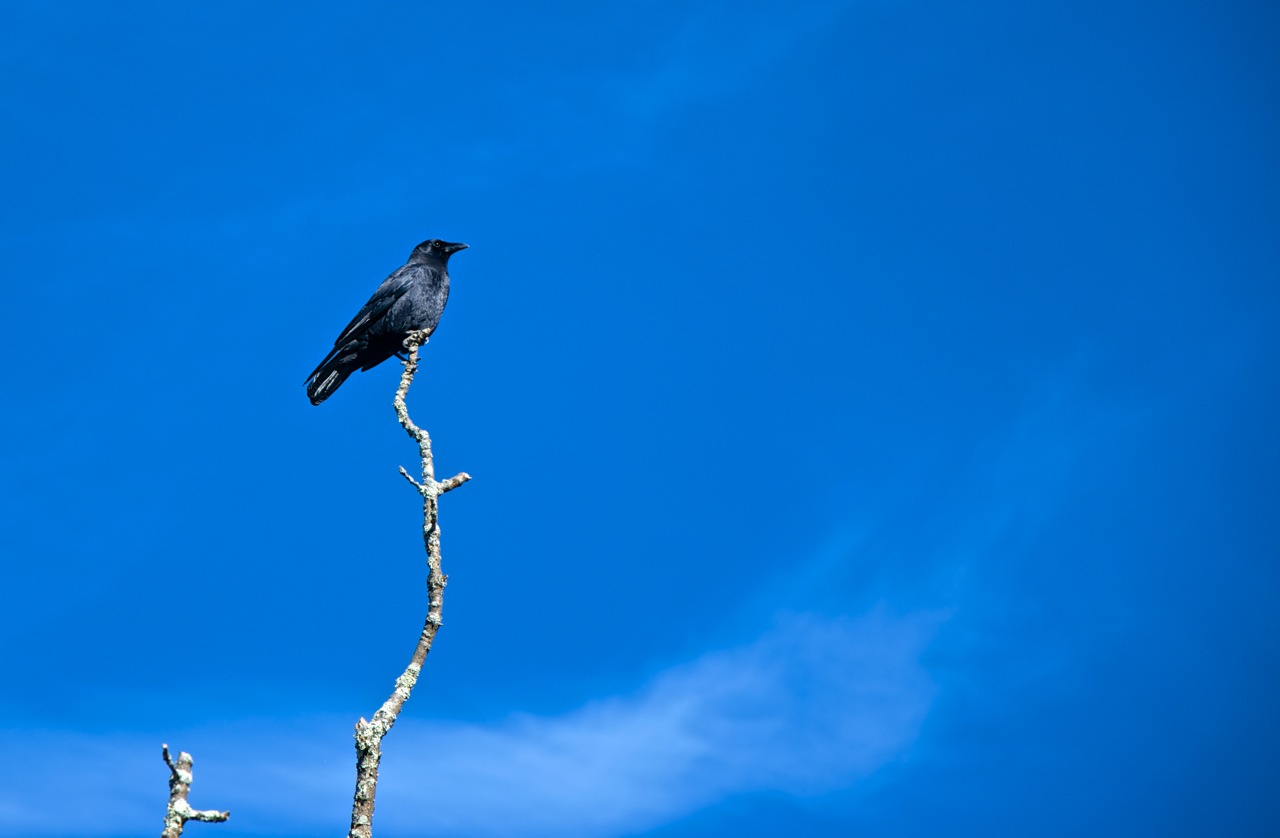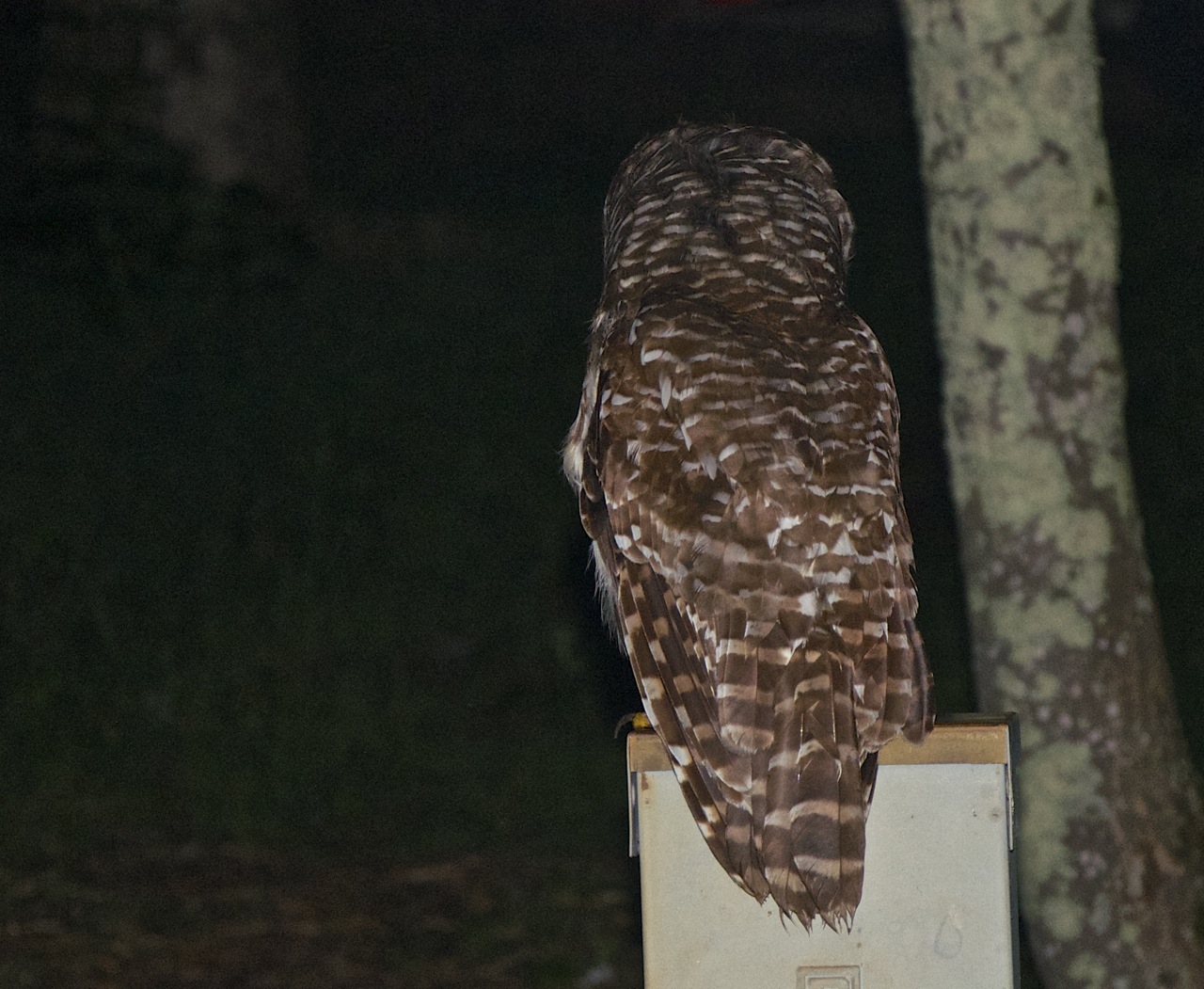“This is an amazing book by an amazing author. Heinrich is a naturalist of the first rank, champion ultramarathoner, woodsman of skills seldom seen in modern times, and not least, as Mind of the Raven illustrates, a nature writer of uncommon talent. By living with the ravens for many years, literally at home and in the field, he has documented a level of intelligence and social sophistication rarely even dreamed to exist in birds.” — E.O. Wilson
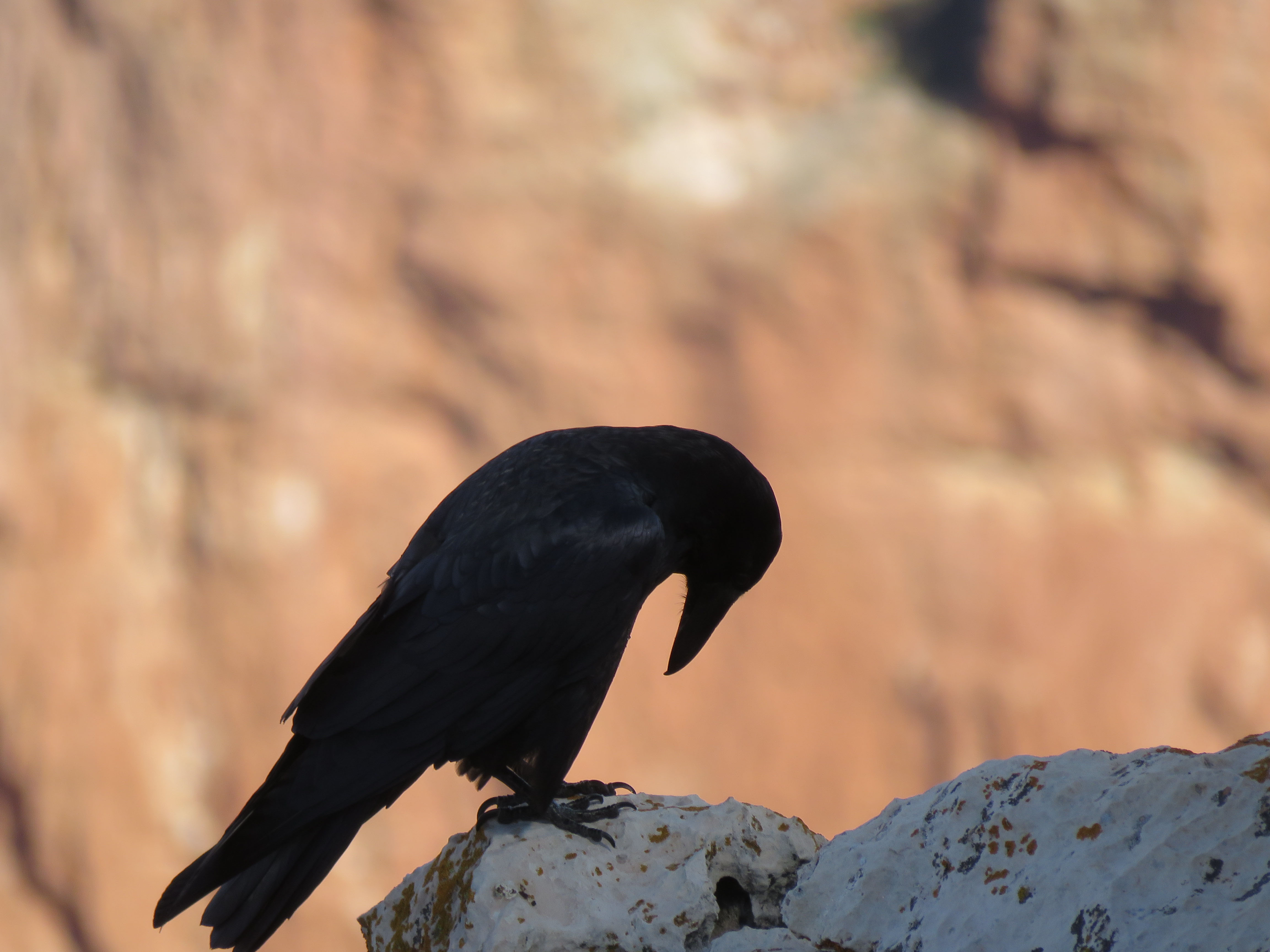
An American Raven [Corvus corax] hanging around the Desert View Watch Tower on the South Rim in Grand Canyon National Park: Glynn Wilson
MIND OF THE RAVEN
Investigations and Adventures With Wolf-Birds.
By Bernd Heinrich.
Illustrated. 380 pp. New York:
Cliff Street Books/
HarperCollins Publishers. $25.
Book Review and More –
By Glynn Wilson –
WASHINGTON, D.C. — Long considered the smartest of birds, ravens [Corvus corax] are celebrated as gods in some cultures, derided as devils in others.
In Scandinavian and Viking culture, the Norse god Odin, sometimes called the Raven God, is often depicted with two ravens as advisers serving as his eyes and ears, one named Huginn (thought) and Muninn (memory).

An illustration from an 18th-century Icelandic manuscript depicting Huginn and Muninn sitting on the shoulders of Odin: Wikipedia
Perhaps because of its black plumage, croaking call and diet of carrion, the raven is often associated with loss and ill omen. Yet, its symbolism is complex.
As a talking bird, the raven also represents prophecy and insight. Ravens in stories often act as psychopomps, connecting the material world with the world of spirits. As a carrion bird, ravens became associated with the dead and with lost souls.
In Swedish folklore, they are the ghosts of murdered people without Christian burials; in German stories, damned souls.
In Greek mythology, ravens are associated with Apollo, the God of prophecy. In Welsh mythology, ravens are repeatedly associated with battles, bravery and death.
The raven is the first species of bird to be mentioned in the Hebrew Bible. In the Book of Genesis, Noah releases a raven from the ark after the great flood to test whether the waters have receded.
The raven also has a prominent role in the mythologies of the Indigenous peoples of the Pacific Northwest, where they consider the raven the Creator of the world, but also an incurable trickster, bringing fire to people by stealing it from the sun, and stealing salmon only to drop them in rivers all over the world.
Raven finds the First Men (and Women)
Ravens can cause trouble for people too. They’ve been implicated in causing power outages by contaminating insulators on power lines, fouling satellite dishes at the Goldstone Deep Space Site, peeling radar absorbent material off buildings at the Chinal Lake Naval Weapons center, pecking holes in airplane wings, stealing golf balls, opening campers’ tents and raiding cars left open at parks.
People the world over sense a certain kind of personality in ravens. Ravens also have a prominent place in art and literature, perhaps most famously in the narrative poem The Raven by American writer Edgar Allan Poe. Poe found them “a little creepy.”
The captive ravens at the Tower of London are beloved and perhaps a little feared: legend has it that if they ever leave the tower, the British Empire will crumble. It has never happened, even when the ravens left, but that’s sometimes the nature of human myth.
Common Ravens can mimic the calls of other bird species. When raised in captivity, they can even imitate human words; one Common Raven raised from birth was taught to mimic the word “nevermore.”
“Quoth the Raven ‘Nevermore’.”
Experience
In my own experience, I’ve watched and photographed ravens in Shenandoah National Park in Virginia, where over a couple of years while camping during the Covid pandemic I saw an adult mated pair scour the Mathews Arm Campground for food on multiple occasions, coming every day at a certain time and working from the top of the hill down to the entrance of the campground. Satisfied, they would fly away with an audible “whoosh, whoosh, whoosh” of their massive wings.
They can sometimes be very shy birds, and these two would not let me get close enough to photograph them. But I did manage to get a few shots.
This is a different raven, photographed in the Big Meadows Campground.
This is in stark contrast to the barred owls around here “who, who” manage to hunt mice and other prey at night without making much of a sound in flight. Although this one made a last minute “whoosh” and “plop” when it landed right behind the campground office in my campsite one night. The office had a problem with mice.
In Yellowstone National Park, after first arriving in the park after the long ascent from the Northeast entrance along Beartooth Pass, and after witnessing the bison feed in a meadow with a soft first snowfall just beginning, I got acquainted with a large, tame raven entertaining people in a picnic area. I don’t know if it was a male or female — it’s hard to tell the difference even for experienced biologists — but it was obviously doing more than scavenging from picnic tables. Visitors had been feeding it in violation of NPS rules.
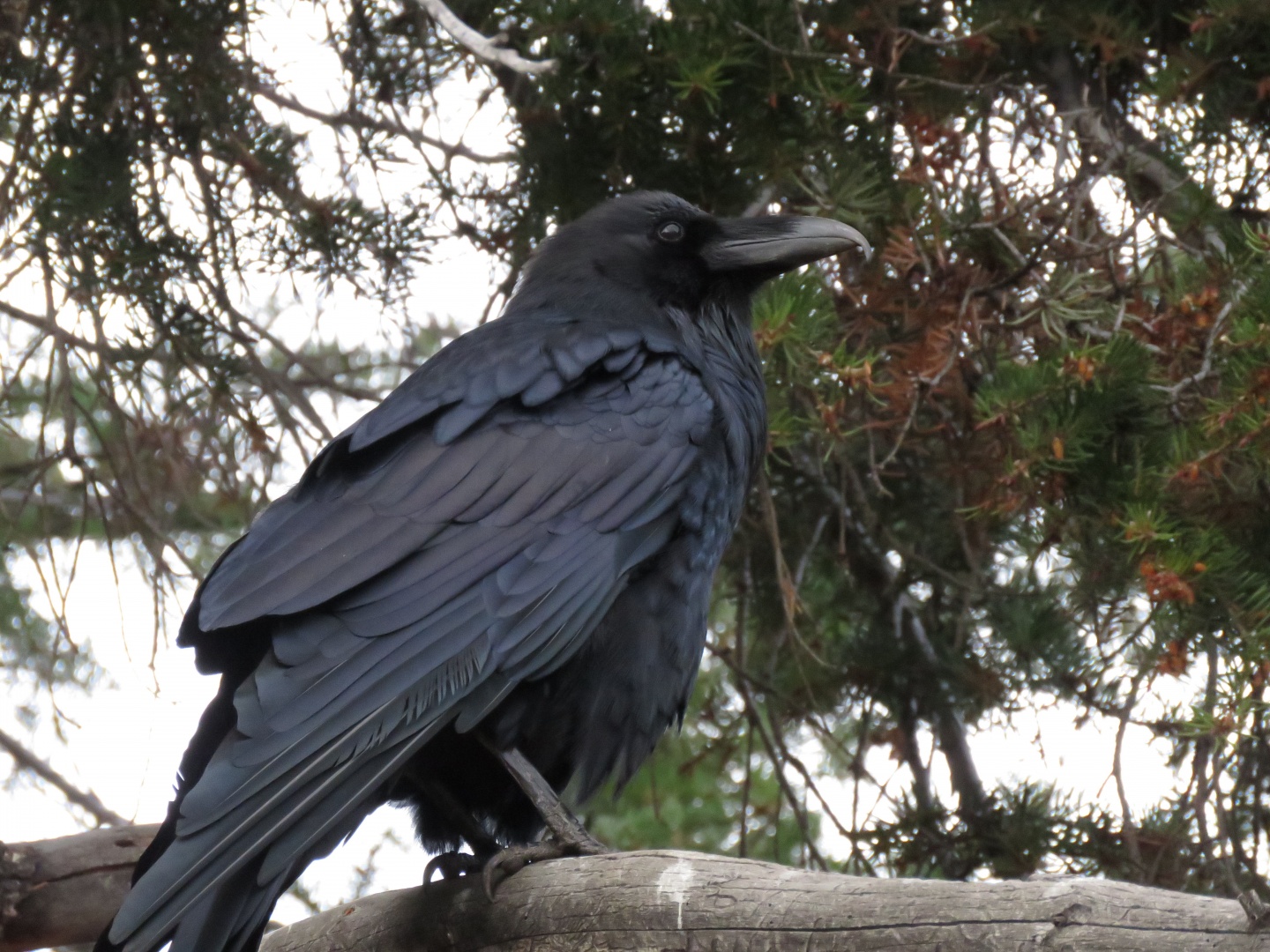
An American Raven [Corvus corax] hitting the tourists up for food in a picnic area in Yellowstone National Park: Glynn Wilson
At the Grand Canyon, I witnessed and photographed ravens playing in the wind currents along the canyon rim.

An American Raven [Corvus corax] hanging around the Desert View Watch Tower on the South Rim in Grand Canyon National Park: Glynn Wilson
I had many questions about the behavior I saw. One night over drinks and conversation, a friend and fellow photographer tipped me off to Heinrich’s work. So I recently looked it up in the local library, and came away understanding the birds in a way I could never have done with my cursory observations. This is why such science is so great. I don’t understand people who seem to hate education and science. We don’t have to observe, wonder and speculate all the time. Some scientists are willing to go to great lengths to study things so we all don’t have to for ourselves.
Science
Considering the amount of science we now have on the biology and social behavior of ravens, it seems a classification mistake to call them “common ravens” [Corvus corax] except in the sense that they do not seem to be an endangered species. Larger cousin to the American crow [Corvus brachyrhynchos] and the fish crow [Corvus ossifragus], thanks to the sometimes heroic efforts of some biologists such as Bernd Heinrich we now have quantitative proof that ravens are not just simple, sentient beings.
Not only do ravens clearly have the ability to experience both positive and negative feelings and pain. They communicate with one another and other species, and demonstrate the capacity to cooperate with each other in pairs, groups and with other species, including wolves, dogs and humans. They show the traits of having mind and memory and the ability to plan ahead, both in pursuit of food and shelter for survival — and for the fun of it. They also experience grief, just like we do, making them the closest animal species to humans, along with some species of apes. We know that far back in our evolutionary history, we didn’t just evolve from apes. Like dinosaurs, we also evolved from birds.
According to the Cornell University online library and definitive bird guide, “the intriguing Common Raven has accompanied people around the Northern Hemisphere for centuries, following their wagons, sleds, sleighs, and hunting parties in hopes of a quick meal.” But according to Heinrich’s in-depth research, it is likely that ravens also helped wolves and early hunters find food as well.
“Ravens are among the smartest of all birds, gaining a reputation for solving ever more complicated problems invented by ever more creative scientists,” Cornell says. “These big, sooty birds thrive among humans and in the back of beyond, stretching across the sky on easy, flowing wingbeats and filling the empty spaces with an echoing croak.”
In fact scientists have documented hundreds of unique sounds and calls made by ravens, even different sounds in far away places, like the forests of other countries. It’s like they have another language there, just like people.
They say to look for ravens anywhere from the outskirts of towns (particularly landfills) to foothill forests or scrub, and out to the deep woods of mountains and national parks. If they’re around you’re likely to hear a deep gurgling croak from far overhead: look for a long-tailed black bird flying on long wings and easy, graceful wingbeats.
They can be distinguished from crows not only by their larger size, but by the downward hook in their bills, and wide fan of a tail.
“The Common Raven is an acrobatic flier, often doing rolls and somersaults in the air,” Cornell says. “One bird was seen flying upside down for more than a half-mile. Young birds are fond of playing games with sticks, repeatedly dropping them, then diving to catch them in midair.”
According to Heinrich’s research, they love to slide down snowbanks like kids on a snow day when school lets out, and make fun of their peers who screw up.
Breeding pairs of ravens hold territories and try to exclude all other ravens (and other predators) throughout the year. Yet according to Heinrich’s research, in winter, young ravens finding a carcass will call other single, juvenile ravens to the prize, which helps young ravens trick adult pairs to chase them, letting their young friends get a chance to feed on the protected cache of food.
This is the question that first intrigued Heinrich to begin his raven research when he witnessed juvenile ravens calling out to others at a food source, when adult pairs would keep quiet to protect their meal.
“Common Ravens are smart,” Cornell admits, “which makes them dangerous predators.”
They sometimes work in pairs to raid seabird colonies, with one bird distracting an incubating adult and the other waiting to grab an egg or chick as soon as it’s uncovered. They’ve been seen waiting in trees as ewes give birth, then attacking the newborn lambs.
“They also use their intellect to put together cause and effect,” Cornell admits.
A study in Wyoming discovered that during hunting season, rather than scaring off the birds, the sound of a gunshot draws ravens in to investigate a carcass, whereas the birds ignore sounds that are just as loud but harmless, such as an airhorn or a car door slamming.
In The New York Times review of the book, nature writer David Quammen seems not so impressed with Heinrich’s writing as with his sometimes nearly heroic physical feats in the interest of science. Heinrich is also a world class marathon winner and record setter.
“By actual measurement they are the brainiest of birds,” Quammen admits of ravens, although he calls it “subjective evidence” that they seem more “sapient” (or wise) than most other living creatures.
Other accounts Quammen calls “anecdotal,” even though Heinrich provides the results of experiment after experiment in his book, portraying ravens using tools, visualization, high analytical skills and even showing foresight.
“Furthermore, they’re famously mischievous,” he admits. “Ravens steal, deceive, clown around acrobatically, mimic human speech and play pranks on dogs.”
In his first book on ravens published in 1989, Ravens in Winter, Heinrich acknowledged the reverential buzz for the large birds but showed some scientific skepticism, when a review of the literature at that time convinced him “that no proof of the raven’s singular intelligence has yet been published.”
But as he began to capture ravens and study them up close in and outside his cabin in Maine, as well as in the wilds of Vermont and later Germany, Canada, Iceland, Alaska and even Yellowstone National Park, the long course of field study and experiments came together in Mind of the Raven.
“Bernd Heinrich is no ordinary biologist,” Quammen admits. “He’s the sort who combines formidable scientific rigor with a sense of irony and an unslaked, boyish enthusiasm for his subject, and who even at his current professorial age seems to do a lot of tree climbing in the line of research.”
And not just any trees, according to the book. Pine trees over 100 feet tall with no limbs until sometimes 60 feet up, all in the dead dawn of winter in Maine, when a foot of snow covers the ground and the temperature is 20 below zero. He climbed some of the trees in the February breeding season to steal young to raise in captivity to study.
“I spent one winter getting up every day hours before dawn to climb tall spruce trees near baits I had put out,” he reports in the book — to watch raven behavior on a food source. His baits were calf carcasses and other meaty offerings, especially dead deer and other roadkill he collected with the help of graduate students. (The whole time he was teaching biology at the University of Vermont).
”Aside from the pure enjoyment of climbing snowy trees in the dark at subzero temperatures, I did it to count birds,” Heinrich says, committed to the quantitative study and not just qualitative analysis and personal anecdotes, although he does tell a few stories to back up his claims that are not on the face of it quantifiable.
Even Quammen admits that Heinrich “has a rare ability to embed dense scientific explications within graceful, light-footed nature writing,” as in Bumblebee Economics, his little 1979 classic on the energetics and foraging strategies of bumblebees.
“Whether he’s studying bees, ravens or African dung beetles, he maintains a strong sense of the ecological fundamentals, asks good questions and complements his field observations with a manic experimentalism,” Quammen writes.
What Heinrich comes to in his research is whether ravens merely pickup useful tricks by observation and then mimic them, as other animals do, such as chimps (monkey see, monkey do). Or whether they have the mental capacity to actually analyze situations in their minds and solve problems. Do they have memory and mind?
Heinrich studies their social relationships, sharing behavior and vocal repertoire. He finds that they have the ability to recognize one another as individuals, as well as tell the difference between humans they come in contact with. He explores their fears, what might be considered their code of morality, and their obsession with play, which he concludes is not just for learning useful behaviors as it appears to be in other animals.
In one of his later experiments, Heinrich ties meat to a string and watches as the ravens figure out how to first pull and work the string up to get the meat off, and then pull the string down from a higher perch, using their feet to hold down the sections of rope.
Heinrich describes research journeys to Germany, where German ravens have an entirely unique repertoire of calls and nest in huge birch trees instead of pines. Rather than using power poll spikes like Heinrich, the German scientists tied filament line to rope and then rope ladders to get up in the nesting trees, many of which were old growth giants that had government protection and were used by the birds year after year.
In a remote village on Baffin Island in the Canadian Arctic, an old man tells him of the collaborative relationship that once prevailed between ravens and hunters. Ravens would fly along with hunting parties and make a wing-dipping move to signal the hunters toward caribou. This story is told in a way showing early belief that with the birds’ help, the hunt would be successful and everyone, humans and birds, would end up with a bountiful feast.
Yet Heinrich’s research and conclusions show skepticism of this tale, and after he witnesses the wing-tipping move in Yellowstone for himself, he indicates that while the move is not likely done to tip hunters off to a food sources over the hill. It is more likely a way for ravens to have fun flying in a wind updraft while they go along with the humans on the hunt. Yet it could very well result in such a successful hunt outcome if humans followed the birds, rather than going off in another direction in the forest and the snow.
So were the ravens following the hunters? Or the hunters following the ravens? Maybe a little bit of both?
At a wolf research center in Nova Scotia, Heinrich learns by experiment that ravens prefer to feed in the presence of wolves, which are seen on multiple occasions feeding together peacefully, while ravens tend to avoid some easy food sources provided by humans with no wolves present.
In Yellowstone National Park, Heinrich nails the research on ravens hunting and feeding with wolves. This confirms for Heinrich why ravens in Maine and Vermont are often skeptical of food he provides and sometimes take a while, having a long conversation with each other and even doing a little dance near the kill, before coming around to feed. It’s the absence of wolves, which help give the ravens confidence that no other predators will come around to harass them. Heinrich points out that this evolutionary behavior must go back hundreds of thousands of years before hominids came along.
After seeing this pattern repeated in Yellowstone, Heinrich begins thinking of ravens as “wolf-birds,” commensal partners of the pack-hunting carnivores upon whom they depend for part of their diet. After seeing the same behavior during an elk hunt north of Yellowstone, he documents and extrapolates that the same sort of bond must have connected human hunting bands and ravens as well.
The birds are not just following the wolves and hunters to get food for themselves. They have a hard time opening up a deer or elk carcass with their beaks without the help of the sharp teeth of the wolves, or the sharp knives of the hunters. They also seem to lead wolves, hunters and other predators to food sources, including bears, which are not as friendly to ravens when they come near a fresh kill. In one documented incident a brown bear was seen trying to chase away ravens from a fresh kill with swipes of a huge paw, and then laying down on top of a dead calf to keep the birds and wolves from getting their fair share.
“Ravens are the quintessential northern bird,” Heinrich writes. “It is no accident that they are also the bird most closely associated with humans in the culture and folklore of northern people.”
___
If you support truth in reporting with no paywall, and fearless writing with no popup ads or sponsored content, consider making a contribution today with GoFundMe or Patreon or PayPal. We just tell it like it is, no sensational clickbait or pretentious BS.


